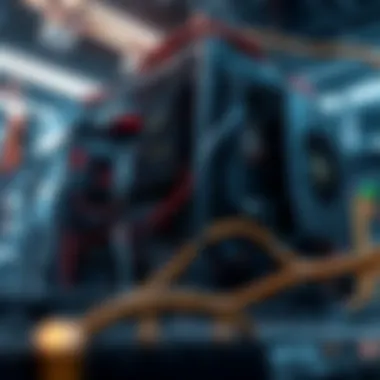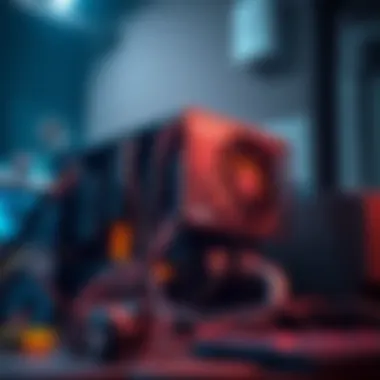Building a Cryptocurrency Mining Rig: The Complete Guide


Intro
Building a cryptocurrency mining rig is a venture that piques the interest of many, not just tech enthusiasts but also investors and traders looking to tap into the thriving crypto market. The allure of generating digital currencies can be tempting, but it’s essential to begin with a solid grasp of the processes involved, market trends, and how to optimize your rig for the best performance. In this article, we’ll traverse the landscape of mining rigs, unpacking essential components and configurations, as well as providing insights into market dynamics that can influence mining success.
Whether you are a seasoned veteran or a newcomer, understanding the foundation is key. A mining rig is akin to a powerful assembly line in a factory, where specific hardware and tailored software work in harmony to solve complex cryptographic puzzles, leading to rewards in the form of cryptocurrencies. Let’s dive into the Understanding Cryptocurrency Market Trends to lay the groundwork for our readers.
Understanding Cryptocurrency Market Trends
Grasping current market trends serves as a compass guiding your mining endeavors. The fluctuations in the cryptocurrency ecosystem can dictate not just the profitability of mining, but also direct investment strategies.
Current Market Analysis
The contemporary climate of cryptocurrency trading showcases a tumultuous yet compelling environment. Bitcoin, Ethereum, and other altcoins exhibit pronounced volatility. Recognizing this, miners must remain adaptable and informed. Market trends can shift due to regulatory changes, technological advancements, or even global events like economic crises, all of which can drive cryptocurrency prices up or down dramatically.
As of now, you’ll find that platforms like Binance and Coinbase are buzzing with activity. Monitoring cryptocurrency websites provides insights into price movements that are crucial for timing your mining operation effectively. Many traders find value in analytics platforms such as Glassnode or CryptoCompare to analyze patterns and upcoming trends.
Historical Performance and Lessons Learned
The historical performance of cryptocurrencies teaches profound lessons. For instance, Bitcoin's meteoric rise in 2017 caught many off-guard but also led to subsequent market corrections that humbled investors and miners alike. Lessons from previous cycles highlight the significance of patience and calculated decision-making. Miners who rushed without conducting thorough research often faced significant losses when prices dipped unexpectedly.
Cryptocurrency markets can be unforgiving. Therefore, understanding the past can help in crafting informative strategies for the present and the future. As you craft your mining rig, keeping an eye on trends derived from historical performance can set a solid foundation.
"In the world of cryptocurrency, knowledge is your safest investment."
From analyzing past cycles to predicting future moves, these insights can aid both investors and miners in navigating the tricky waters of digital currencies. With a sound understanding of market dynamics in hand, let’s shift our focus to practical guides for crypto investors.
Practical Guides for Crypto Investors
Having a robust strategy is vital for success in the mining business. As we delve deeper into key aspects of constructing a mining rig, it’s essential to equip yourself with practical guides tailored for the crypto investor.
Step-by-Step Trading Strategies
When diving into the mining world, start by selecting the appropriate cryptocurrency to mine. Bitcoin may often come to mind, but it’s wise to calculate potential profitability by comparing costs such as electricity, hardware, and pool fees against expected returns. Utilizing mining profitability calculators, like those found on WhatToMine or Minerstat, can guide your selection.
Risk Management Techniques
It’s crucial to implement sound risk management techniques. Here’s how you can safeguard your investing journey:
- Diversify: Don’t put all your eggs in one basket. Consider mining multiple cryptocurrencies.
- Stay Informed: The crypto landscape is always evolving; keeping informed about regulations, technology, and market trends is essential.
- Set Limits: Establish clear profit and loss limits for your mining operations, ensuring you have an exit strategy in case of market downturns.
As we move forward in this guide, we'll explore essential hardware components and software configurations to ensure your mining rig is built for performance and resilience.
Prelude to Cryptocurrency Mining
Cryptocurrency mining has evolved into a cornerstone of the blockchain technology landscape. As interest in digital currencies surges, understanding the fundamentals of mining becomes paramount for investors, traders, and tech enthusiasts alike. Mining isn't merely the act of generating new coins; it's a vital process that legitimizes transactions and keeps the entire network operating smoothly. The process also presents a unique opportunity—constructing a mining rig can yield profitability if approached wisely.
Understanding Cryptocurrency Mining
At its core, cryptocurrency mining refers to the process in which transactions are verified and added to the public ledger, known as the blockchain. Miners solve complex mathematical problems to validate these transactions, and in return, they receive newly created cryptocurrencies as rewards. This duality of validation and reward is crucial; it ensures trust within a decentralized system while generating intrinsic value.
In straightforward terms, mining serves as the backbone of the cryptocurrency ecosystem. Without it, the network could suffer from fraud and double-spending. Moreover, miners contribute to the network's security, making unauthorized alterations nearly impossible. The more miners vibrant in the network, the more secure and efficient it becomes. Thus, understanding mining goes beyond technicalities—it touches the foundational principles of trust and integrity in cryptocurrency.
The mining landscape is characterized by increasing competition and innovation. Miners must stay informed about the latest technologies and trends, as proper hardware selection and optimal configurations can significantly affect overall performance. This guide aims to demystify the mining process, making it accessible to those who seek to embark on this journey.
The Role of Mining in the Blockchain Ecosystem
Mining assumes a crucial role in the operation of blockchain networks. It's akin to a decentralized consensus mechanism that differentiates this space from traditional finance. The benefits of cryptocurrency mining are manifold:
- Security: Each mining effort adds layers of security. The collective computational power of miners acts as a form of defense against malicious attacks.
- Supply Regulation: Mining cryptocurrencies like Bitcoin involves a predictable issuance rate. This algorithmic foundation ensures stability within the market.
- Transaction Validation: Every transaction must be verified and stored in the blockchain. Miners act as arbiters, making sure transactions are legitimate and properly logged.


These benefits highlight why mining is not just about creating coins and profits; it plays an essential part in maintaining the integrity of the blockchain. As the ecosystem grows, so too does the complexity of mining, inviting both seasoned professionals and newcomers to dive deeper into understanding this intricate art.
Essential Components of a Mining Rig
Building a mining rig isn't just about throwing together some hardware. It's akin to assembling a well-oiled machine, where each part plays a crucial role in achieving efficient cryptocurrency mining. Understanding essential components is vital; it’s like knowing the engine of a car to ensure it runs smoothly. Without the right setup, all your efforts can be in vain, and an improperly configured rig can lead to inefficiencies and additional costs. Let's break down the key elements that comprise a successful mining setup.
Graphics Processing Units (GPUs)
At the heart of every mining rig lies the Graphics Processing Unit (GPU). Think of GPUs as the workhorses of the operation. They handle the complex calculations required to validate transactions on the blockchain. The right choice of GPU can make a world of difference—some cards excel at heavy computation, while others offer better energy efficiency. When selecting GPUs, here are a few factors to consider:
- Performance vs. Efficiency: Higher hash rates often come with increased power consumption. Striking the right balance can drastically impact your profit margins.
- Cooling Needs: GPUs generate significant heat while mining. Therefore, investing in reliable cooling solutions is critical to maintaining performance and prolonging hardware life.
- Availability and Cost: In a fluctuating market, the price and availability of GPUs can vary immensely.
It's wise to compare different models and read up on user reviews to see how they perform in real-world mining scenarios.
Motherboard Considerations
The motherboard is the backbone of any mining rig. It needs to support multiple GPUs, provide stable power, and have enough ports for other peripherals. Choosing the right motherboard isn't just a checkbox on a list; it’s crucial for ensuring all components work harmoniously. Key aspects include:
- Slot Configuration: Look for motherboards with multiple PCIe slots. This allows for a greater number of GPUs, enhancing your mining capacity.
- Stability: A rock-solid motherboard can handle the continuous load of mining operations. Opt for brands known for durability in high-performance scenarios.
- BIOS Compatibility: Ensure the motherboard’s BIOS is compatible with various GPUs. This can save you time during setup and reduce potential headaches down the line.
Selecting a motherboard might seem trivial compared to GPU choices, but a poorly chosen board can bottleneck your mining performance.
Power Supply Requirements
Imagine trying to power a fleet of trains with a simple car battery; that's how it feels when miners overlook power supply units (PSUs). Without sufficient and stable power, even the most robust mining rig will underperform. Here are the focal points regarding power supply:
- Wattage: Total your GPUs’ power consumption and choose a PSU with more wattage than you think you'll need—generally, a buffer of 20% is a good rule of thumb.
- Efficiency Ratings: Look for PSUs with 80 PLUS ratings. They guarantee better energy efficiency and can help minimize electricity costs.
- Modular Design: Consider opting for a modular PSU, as they allow you to use only the cables you need, reducing clutter and improving airflow in your rig.
Choosing the right power supply can safeguard the longevity of your entire setup.
Cooling Systems
The importance of proper cooling cannot be stressed enough. GPUs and other components generate significant heat during mining operations. An overheated rig can lead to thermal throttling, causing poor performance or even damage. Here’s a breakdown of cooling options:
- Air Cooling: This is the most common and often the easiest method. Use high-quality fans to keep air circulating effectively through the rig’s components.
- Liquid Cooling: For those pushing the boundaries of performance, liquid cooling offers outstanding efficiency and temperature management, though it comes with higher setup costs.
- Environment: Positioning your rig in a well-ventilated area can greatly affect cooling efficiency. Consider the ambient temperature and airflow in your mining location.
Can’t stress it enough: maintain a cool environment—it’s essential for longevity and performance.
"The right cooling can be the difference between a profitable mining venture and a malfunctioning rig."
The End
Understanding these essential components is the key to building a successful mining rig. Each element must be compatible and high-quality to ensure efficient performance. Assembling a rig without paying attention to these vital components would be like constructing a house on a shaky foundation—it’s bound to crumble. As you venture into the next steps of your mining journey, remember: it’s not just about the individual parts, but how they come together to create a powerful system.
Steps to Build a Mining Rig
Building a mining rig is not just a technical endeavor but a significant investment in the cryptocurrency space. Whether you're a first-time miner or looking to upgrade, understanding the steps involved in constructing a mining rig can lead to better performance and efficiency of your mining operations. A well-built rig can boost productivity and maximize your returns, while also reducing potential headaches that can arise during its operation. This section lays out the necessary steps to establish a functional mining rig, ensuring you are well-equipped to tackle the task.
Gathering Necessary Tools and Components
Before you dive into the nitty-gritty of assembling your mining rig, gathering the right tools and components is critical. Think of this phase as laying down the foundation of a house; you wouldn’t start building without first having the plumbing and electrical systems planned, right? Here’s what you need to have ready:
- Essential Hardware
- Tools Needed
- Graphics Processing Units (GPUs): This is the heart of your mining rig; try to choose high-performance ones. Brands like NVIDIA and AMD are known for their mining capabilities.
- Motherboard: Ensure it supports multiple GPUs, and pick one with strong connectivity options.
- Power Supply Units (PSU): Opt for a power supply that can handle the load of your components. A good rule is to check the wattage requirements of your GPUs and add a margin to ensure stability.
- Cooling Units: Since mining rigs can generate a fair bit of heat, having adequate cooling through fans or water cooling systems is essential.
- Screwdrivers (both Phillips and flathead)
- Anti-static wrist strap to protect components from static electricity
- Cable ties for neat organization
The importance of having all tools ready cannot be stressed enough. Starting with a complete toolkit saves time and frustration mid-build.


Assembling the Rig
Now, this is where the fun begins. The assembly process can be divided into clear, manageable steps:
- Install the CPU and RAM: Begin by mounting the CPU in the motherboard socket. Secure it according to the motherboard manual, then plug in the RAM modules.
- Attach the Cooling System: If you’re using an air cooler, make sure to apply thermal paste to the CPU before fitting the cooler. Follow the instructions to ensure it's securely fastened.
- Install the Motherboard in the Frame: Use the standoffs to mount the motherboard in the rig frame. Ensure that there's enough space to allow airflow between the components.
- Install GPUs: Secure the GPUs into the PCIe slots carefully. Each GPU needs to be fastened properly to avoid any accidental dislodging during operation.
- Connect Power Supply: Link the power supply to the motherboard and GPUs. It’s vital to follow the schematics on the PSU and motherboard to avoid errors.
- Cable Management: Here’s where cable ties come handy again. Keeping cables organized not only looks better but will also help with airflow.
Installing Software and Drivers
With the physical assembly completed, it's time to breathe life into your mining rig through software.
- Operating System: Choose a lightweight operating system for your mining rig. Many miners prefer Linux-based systems as they tend to be more efficient. Install your chosen OS and ensure it's updated.
- GPU Drivers: Installing the latest drivers for your GPUs is ultramportant. This ensures optimal compatibility and performance. Check the official NVIDIA or AMD sites for the newest drivers.
- Mining Software: This is where you'll make some choices. Popular mining software includes Ethminer for Ethereum and CGMiner for Bitcoin. Download and configure according to your preferences.
- Configure Settings: After the software setup, it's time to tweak settings. Set your mining pool config, choose the correct coin to mine, and adjust any performance parameters.
Following these steps with attention to detail can lay the groundwork for a successful mining operation.
In the next sections, we will delve deeper into optimizing your mining rig for ultimate performance and ensuring its longevity.
Configuring Mining Software
The choice of mining software can make or break your operation. Selecting the right software is crucial because it directly affects your mining efficiency, ease of management, and overall profitability. It becomes the interface between your hardware and the cryptocurrency blockchain, translating the computational efforts of the mining rig into tangible rewards. In this section, we will delve into two key aspects of mining software: determining the best software for your needs and understanding the dynamics of mining pools and solo mining.
Choosing the Right Mining Software
When it comes to mining software, it’s not a one-size-fits-all situation. The software you select greatly depends on a variety of factors including the specific cryptocurrency you aim to mine, your GPU configuration, and whether you’re mining solo or in a pool. Here are some popular mining software options to consider, each with its unique benefits:
- CGMiner: Often considered a go-to for serious miners, CGMiner offers raw power and flexibility. With command line interfacing, it allows extensive customization for advanced users.
- BFGMiner: This is similar to CGMiner but tailored for FPGA and ASIC miners. It prioritizes adjustable settings relevant to hardware management, which could be vital depending on your setup.
- EasyMiner: For newcomers looking for a friendly interface, EasyMiner may be your best bet. It's well-suited for beginners, facilitating an easy introduction into the mining world.
- NiceHash: This platform allows you to rent out your computing power and get paid in Bitcoin—an appealing choice for those looking to get their feet wet without upfront investments in crypto.
The importance of selecting the right software cannot be overstated; it can affect not only your profitability but also the longevity of your mining rig. It’s also worth checking reviews and user experiences, which enhance your understanding of what to expect from each software option.
Exploring Mining Pools versus Solo Mining
Deciding between solo mining and joining a mining pool is akin to selecting between sailing alone or with a crew. Each approach has its own rewards and pitfalls, and understanding these can enhance your mining experience significantly.
Solo mining involves mining independently, using your equipment to solve cryptographic puzzles and verify transactions. While it may sound appealing, it comes with considerable challenges:
- High Variability in Rewards: You may secure a block and receive rewards, but the chances are often slim due to increased competition.
- Costly Resources: You bear all costs, including electricity and hardware maintenance.
Conversely, mining pools allow miners to combine their computational power, improving the chances of solving blocks and subsequently sharing rewards based on effort contributed.
Advantages of mining pools include:
- Steady Income: More frequent but smaller payouts.
- Less Strain on Resources: Pooling resources can mitigate individual costs and risks.
However, it’s important to scrutinize pool fees and policies before joining, as each pool operates distinctly. Some may charge fees that could chip away at your earnings. Additionally, if you decide to pool your efforts, make sure to engage with communities on platforms like Reddit or mining forums to gain insights on user experiences with particular pools.
When configuring mining software and deciding on participation mode, always remember to align your choices with your overall mining strategy. Stay informed and flexible as new opportunities and technologies arise in this ever-evolving landscape of cryptocurrency mining.
Optimizing Mining Performance
In the realm of cryptocurrency mining, the phrase "work smarter, not harder" rings particularly true. Optimizing mining performance is essential, as it determines not only the efficiency of your setup but also how much profit you can generate from your operations. Whether you are an investor, a trader, or even a tech professional, understanding the nuances of optimization is critical.
By maximizing the extraction of monetary value from each mining session, you can ensure that your initial investment pays off. The key elements of optimization include overclocking the GPUs and managing power efficiency. Both require careful consideration and planning but can significantly improve your overall performance.
Here’s what to focus on that can take your mining operation to the next level:
- Maximizing hash rates. This is the speed at which your rig can solve the cryptographic puzzles that validate transactions.
- Minimizing power consumption. It's not just about how much you can mine but how efficiently you can do so.
- Maintaining component longevity. Over-optimizing can lead to components overheating and failing. Striking a balance is key.
Remember: Effective optimization not only boosts your output but also enhances the longevity of your mining rig.
Overclocking GPUs Effectively


Overclocking is a term that commonly surfaces in the mining community. It involves adjusting the clock speed settings of your GPU to exceed the manufacturer’s specifications. The primary goal is to yield higher hash rates. While overclocking can indeed produce performance bumps, it also carries the risk of overheating.
When undertaking overclocking, consider the following steps:
- Start Slow. Incrementally increase clock speeds to monitor the stability of your system.
- Test for Stability. Run benchmarking software to ensure that your system remains stable at the new settings.
- Monitor Temperatures. Use tools such as HWMonitor to track thermal performance closely.
- Fine-Tune Settings. If temperatures climb too high or crashes occur, dial back your clock speeds incrementally.
Specific software tools, like MSI Afterburner or EVGA Precision X1, can aid in making these adjustments more manageable. Choose wisely, as not all applications offer the same features or safety nets.
Managing Power Efficiency
In cryptocurrency mining, electricity is the proverbial lifeblood. Every watt counts, and hence, managing power efficiency is pivotal. It is not just about finding the cheapest electricity rates; it's also about how your hardware utilizes what it consumes.
Elements to Improve Power Efficiency:
- Use Energy-Efficient Components. Newer GPUs tend to be more efficient than older models. For instance, NVIDIA's latest generation has been designed with power conservation in mind.
- Optimize Your Mining Software. Certain mining applications allow settings that reduce power usage while maintaining performance.
- Employ Power Supply Units (PSUs) Wisely. A high-quality PSU can help provide stable energy demand while being energy-efficient. Look for units that are 80 PLUS certified.
- Leverage Power Management Settings. Modern GPUs often come with built-in features to limit power draw.
Implementing these measures will not only help reduce your electricity expenditure but will also extend the life of your mining rig. The added long-term savings can substantially increase your net returns. Remember, the goal is not just to mine cryptocurrency, but to do so in a way that maximizes returns and minimizes overheads.
Maintaining Your Mining Rig
Maintaining your mining rig is not just about keeping the components clean; it’s crucial for ensuring longevity, performance, and ultimately, profitability. Neglecting maintenance can lead to hardware failures or inefficiencies that could eat away at your returns. Just like a car needs regular oil changes and tune-ups, your mining rig demands consistent care to keep it humming along smoothly.
Proper maintenance practices help you identify issues early, optimize performance, and extend the lifespan of your hardware. This section dives into the essential routines and troubleshooting strategies that every miner should consider.
Routine Maintenance Practices
A well-kept mining rig can experience fewer technical problems and run more efficiently. Here are some routine maintenance practices to consider:
- Clean Up Dust Buildup: Dust is an insidious villain in the mining world. Accumulating dust can clog fans and heat sinks, causing overheating. Regularly using compressed air to clean fans and components helps mitigate this issue. Aim for a bi-weekly or monthly schedule for cleaning.
- Monitor Temperatures: Use software to monitor the temperature of key components like GPUs and CPUs. Keeping the hardware cool is essential, as high temperatures can shorten their lifespan. If you're seeing high numbers, think about upgrading cooling solutions.
- Check Connections: Over time, connectors can become loose. Inspect the power cables and connections to ensure they are secure. Periodically unplugging and replugging these connections can help maintain a good electrical contact. Don't forget to periodically check RAM and any other peripherals, too.
By establishing a routine that includes these practices, you not only enhance efficiency but also make sure your rig operates at peak capacity.
Troubleshooting Common Issues
Despite your best efforts, issues may still arise. Here are common problems miners face and their potential fixes:
- Rig Not Booting: If your mining rig refuses to start, the first step is to check the power supply. Ensure it is plugged in and functioning. Sometimes, a simple reseating of GPUs or RAM can do the trick. A careful examination of error codes or motherboard LEDs can also provide vital clues.
- Overheating: If temperatures are consistently high, it could signal insufficient cooling. As mentioned earlier, cleaning out dust is essential, but also consider reapplying thermal paste on GPUs that have been running for a while. If that doesn't bring temperatures down, you may need to look into upgraded cooling solutions.
- Low Hash Rates: A sudden drop in hash rates can be frustrating. Start by checking if your mining software is correctly configured. Ensure your setup isn’t running too many processes in the background, as this can hog valuable resources. Overclocking settings might also need to be adjusted.
"The key to effective troubleshooting is staying calm and methodical. Don’t rush to conclusions."
If these issues persist, seeking advice from forums such as Reddit can provide useful insights and community-driven solutions.
Maintaining your mining rig isn't just a chore—it's an investment in your cryptocurrency operation. Regular upkeep and quick troubleshooting allow you to maintain optimal performance for the long haul.
Understanding Profitability and ROI
When stepping into the world of cryptocurrency mining, understanding profitability and return on investment (ROI) is not just important; it's essential. Without grasping these concepts, miners can easily find themselves digging a financial pit.
Mining profitability primarily hinges on two critical elements: rewards earned from mining and costs associated with running the rig. The balance between these two can be the difference between mining success and failure. With market volatility, fluctuations in mining rewards, and various operational costs like electricity and hardware investments, you need a sharp mind to navigate this complex landscape.
Calculating Mining Rewards
Mining rewards refer to the cryptocurrency earned by successfully mining a block. This reward can vary based on multiple factors:
- Block Reward: Each cryptocurrency offers a specific reward for discovering a new block.
- Transaction Fees: Miners often earn additional income from fees included in the transactions they validate.
- Difficulty Level: As more miners join the network, the difficulty of solving the cryptographic problem increases, which can affect the rewards.
To calculate your potential rewards, understanding the hash rate of your rig is vital. The hash rate refers to the speed at which your mining rig can perform calculations:
A higher hash rate typically leads to a greater chance of earning rewards.
A simple formula can serve to gauge mining profit:
Profit = (Mining Reward x Market Price) - Operational Costs















